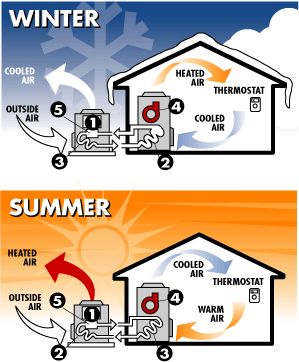Heat Pump 101
Terminology
Air Conditioning 101

An electric heat pump can heat your home during the winter and cool it during the summer. The major parts of a heat pump include:
1. Compressor: This increases the pressure of the refrigerant so that it will accept the maximum amount of heat from the air.
2. Condenser: Coils that move heat to or from the outside air.
3. Evaporator: Coils that move heat to or from the air inside the home.
4. Air handler: Fan that blows the air into the ducts of the home. Components 1, 2, 3 and 4 are found in all standard air conditioners.
5. Reversing valve: Changes the heat pump from air conditioning to heating, and vice versa. This is not part of the thermostat.
How Heat Pumps Work
AC Mode
Warm air in your house is sucked into the return vents (the vents that are not adjustable), through the return ductwork system, and is then blown across the evaporator coil inside your air handler located in your home. The evaporator coil contains refrigerant which was pumped into your house from the outdoor air conditioning unit (the condensing unit). Like a dry sponge absorbing water, the refrigerant absorbs the heat out of the warm air. Once the heat is absorbed out of the air, the now cooled air is blown back through the supply ductwork system into your house through the supply vents (the vents that can be adjusted with the little knobs). The refrigerant, which has just absorbed the heat from your house, is then pumped to the outdoor condensing unit. The outdoor condensing unit operates in a similar fashion to the evaporator coil in your house. A fan pulls outside air across another set of coils (the condensing coils) where the air absorbs the heat out of the refrigerant. This is similar to wringing out the sponge and giving the water to the outside air. After this process, in which the refrigerant just gave the heat that was absorbed from your house to the outside air, the refrigerant is rejuvenated and is then sent back to the evaporator coil in your home to absorb more heat.
Heat Mode
A reversing valve in the outdoor unit reverses the flow of refrigerant. The outdoor coil is now the evaporator coil. The refrigerant absorbs the heat out of the outside air which is warmer than the refrigerant. Once the heat is absorbed out of the air, the refrigerant is then pumped to the air handler. Cold air in your house is sucked into the return vents (the vents that are not adjustable), through the return ductwork system, and is then blown across the condensing coil inside your air handler where the air absorbs the heat out of the refrigerant. After this process, in which the refrigerant just gave the heat that was absorbed from outside air to the air in the house, the refrigerant is rejuvenated and is then sent back to the evaporator coil outside your home to absorb more heat.

An electric heat pump can heat your home during the winter and cool it during the summer. The major parts of a heat pump include:
1. Compressor: This increases the pressure of the refrigerant so that it will accept the maximum amount of heat from the air.
2. Condenser: Coils that move heat to or from the outside air.
3. Evaporator: Coils that move heat to or from the air inside the home.
4. Air handler: Fan that blows the air into the ducts of the home. Components 1, 2, 3 and 4 are found in all standard air conditioners.
5. Reversing valve: Changes the heat pump from air conditioning to heating, and vice versa. This is not part of the thermostat.
How Heat Pumps Work
AC Mode
Warm air in your house is sucked into the return vents (the vents that are not adjustable), through the return ductwork system, and is then blown across the evaporator coil inside your air handler located in your home. The evaporator coil contains refrigerant which was pumped into your house from the outdoor air conditioning unit (the condensing unit). Like a dry sponge absorbing water, the refrigerant absorbs the heat out of the warm air. Once the heat is absorbed out of the air, the now cooled air is blown back through the supply ductwork system into your house through the supply vents (the vents that can be adjusted with the little knobs). The refrigerant, which has just absorbed the heat from your house, is then pumped to the outdoor condensing unit. The outdoor condensing unit operates in a similar fashion to the evaporator coil in your house. A fan pulls outside air across another set of coils (the condensing coils) where the air absorbs the heat out of the refrigerant. This is similar to wringing out the sponge and giving the water to the outside air. After this process, in which the refrigerant just gave the heat that was absorbed from your house to the outside air, the refrigerant is rejuvenated and is then sent back to the evaporator coil in your home to absorb more heat.
Heat Mode
A reversing valve in the outdoor unit reverses the flow of refrigerant. The outdoor coil is now the evaporator coil. The refrigerant absorbs the heat out of the outside air which is warmer than the refrigerant. Once the heat is absorbed out of the air, the refrigerant is then pumped to the air handler. Cold air in your house is sucked into the return vents (the vents that are not adjustable), through the return ductwork system, and is then blown across the condensing coil inside your air handler where the air absorbs the heat out of the refrigerant. After this process, in which the refrigerant just gave the heat that was absorbed from outside air to the air in the house, the refrigerant is rejuvenated and is then sent back to the evaporator coil outside your home to absorb more heat.


